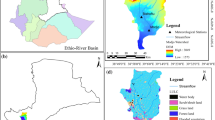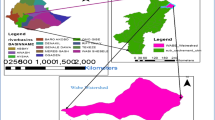Abstract
Impact of spatial data availability on the temperature and precipitation prediction characteristics of Weyib River basin in Ethiopia has been investigated using CMIP5-CanESM2 model for the RCP8.5, RCP4.5 and RCP2.6 scenarios. The objective of the present study is to characterize how future temperatures and precipitation prediction under CMIP5-CanESM2 model output varies against diverse averaged arbitrary spatial weather stations found in the basin. The statistical downscaling model tested and verified using the observed daily data for twelve, six and three averaged arbitrary spatial weather stations as well as for a single weather station was used to predict the future climate scenarios. The results revealed that the mean annual daily maximum and minimum temperature and precipitation for twelve, six and three arbitrary spatial stations have revealed an increasing trend in the upcoming periods until the end of the century. In single station analysis, the trend itself has changed from increasing trend to decreasing trend in case of maximum and minimum temperature. In case of precipitation, no visible trend has been observed in case of single station analysis. Therefore, the variation in amount and distribution of precipitation and temperature among the four averaged spatial stations in the same study area might affect the water resources and agriculture of the basin and also instead of using a single weather station to predict future climate variables for a particular study basin, it is more reliable using averages of numerous spatial weather stations data.













Similar content being viewed by others
References
Alexandrov V, Genev M (2003) Climate variability and change impact on water resources in Bulgaria. Eur Water 12:25–30
Barman S, Bhattacharjya RK (2015) Comparison of linear regression, non-linear regression and artificial neural network model for downscaling of rainfall at Subansiri river basin, Assam, India. Eur Water 51:51–62
Bates B, Kundzewicz Z, Wu S (2008) Climate change and water. Tech Pap Intergov Panel Clim Chang IPCC Secre :210. doi: 10.1016/j.jmb.2010.08.039
Beck L, Bernauer T (2011) How will combined changes in water demand and climate affect water availability in the Zambezi river basin? Glob Environ Chang 21:1061–1072. doi:10.1016/j.gloenvcha.2011.04.001
Bliss K, Bowe KF (2011) Bridging knowledge gaps in water management: integrating approaches to food, water, energy, and the environment. A report of the CSIS project on global water policy. Center for Strategic and International Studies, Washington, DC
Boko M, Niang I, Nyong A (2008) Africa. Clim Chang 2007 Impacts, Adapt vulnerability Contrib Work Gr II to Fourth Assess Rep Intergov Panel Clim Chang p 433–467. doi: 10.2134/jeq2008.0015br
Carvalho M, Serralheiro R, Real JC, Valverde P (2015) Implications of climate variability and future trends on wheat production and crop technology adaptations in southern regions of Portugal. Water Utility J 9:13–18
Dinar A (2006) District level hydro-climatic time series and scenario analysis to assess the impacts of climate change on regional water resources and agriculture in Africa. Discussion paper no. 13. Special Series on Climate Change and Agriculture in Africa, p 60. ISBN 1–920160–01-09
Ethiopian National Meteorological Agency (2007) Climate Change National Adaptation Programme of Action (Napa) of Ethiopia. p 1–73
Faramarzi M, Abbaspour KC, Ashraf Vaghefi S et al (2013) Modeling impacts of climate change on freshwater availability in Africa. J Hydrol 480:85–101. doi:10.1016/j.jhydrol.2012.12.016
Ghosh S, Mujumdar PP (2008) Statistical downscaling of GCM simulations to streamflow using relevance vector machine. Adv Water Resour 31:132–146. doi:10.1016/j.advwatres.2007.07.005
Graham LP, Andersson L, Horan M (2011) Using multiple climate projections for assessing hydrological response to climate change in the Thukela River basin, South Africa. Phys Chem Earth 36:727–735. doi:10.1016/j.pce.2011.07.084
IPCC (2013) Climate change 2013: The physical science basis. Contribution of working group I to the fifth assessment report of the intergovernmental panel on climate Change. Intergov panel Clim Chang Work Gr I Contrib to IPCC Fifth Assess Rep (AR5)(Cambridge Univ Press New York) 1535. doi: 10.1029/2000JD000115
Kruger AC, Shongwe S (2004) Temperature trends in South Africa: 1960-2003. Int J Climatol 24:1929–1945. doi:10.1002/joc.1096
Liu L, Liu Z, Ren X et al (2011) Hydrological impacts of climate change in the Yellow River basin for the 21st century using hydrological model and statistical downscaling model. Quat Int 244:211–220. doi:10.1016/j.quaint.2010.12.001
Loukas A, Sidiropoulos P, Mylopoulos N (2015) Assessment of the effect of climate variability and change and human intervention in the lake Karla aquifer. Eur Water 49:19–31
Mpelasoka FS, Chiew FHS (2009) Influence of rainfall scenario construction methods on runoff projections. J Hydrometeorol 10:1168–1183. doi:10.1175/2009JHM1045.1
New M, Hewitson B, Stephenson DB (2006) Evidence of trends in daily climate extremes over southern and West Africa. J Geophys Res Atmos 111:–11. doi:10.1029/2005JD006289
Serur AB, Sarma AK (2016a) Evaluation of the ArcSWAT model in simulating catchment hydrology: in Weyib River basin, bale mountainous area of southeastern Ethiopia. Int. J, Inov. Emrg. Res. Eng 3(2):3–11
Shawul AA, Alamirew T, Melesse AM and Chakma S (2016) Climate change impact on the hydrology of Weyib River watershed, bale mountainous area, Ethiopia. In: Landscape Dynamics, Soils and Hydrological Processes in Varied Climates. Springer International Publishing, p 587–613
Shongwe ME, Van Oldenborgh GJ, Van Den Hurk BJJM et al (2009) Projected changes in mean and extreme precipitation in Africa under global warming. Part I: Southern Africa J Clim 22:3819–3837. doi:10.1175/2009JCLI2317.1
Unganai LS (1996) Historic and future climatic change in Zimbabwe. Clim Res 6:137–145. doi:10.3354/cr006137
Wilby RL, Dawson CW (2007) SDSM 4.2-A decision support tool for the assessment of regional climate change impacts, Version 4.2 User Manual. Lancaster Univ Lancaster/Environment Agency Engl Wales. p 1–94
Wilby RL, Dawson CW, Barrow EM (2002) SDSM-a decision support tool for the assessment of regional climate change impacts. Environ Model Softw 17:145–157. doi:10.1016/S1364-8152(01)00060-3
Acknowledgements
We express our heartfelt gratitude to Ethiopian Meteorological Service Agency (EMSA) for providing us the meteorological data to be considered for this study.
Author information
Authors and Affiliations
Corresponding author
Rights and permissions
About this article
Cite this article
Serur, A.B., Sarma, A.K. Impact of Spatial Data Availability on Climate Change Prediction in the Weyib River Basin in Ethiopia. Water Resour Manage 31, 1809–1824 (2017). https://doi.org/10.1007/s11269-017-1613-x
Received:
Accepted:
Published:
Issue Date:
DOI: https://doi.org/10.1007/s11269-017-1613-x




